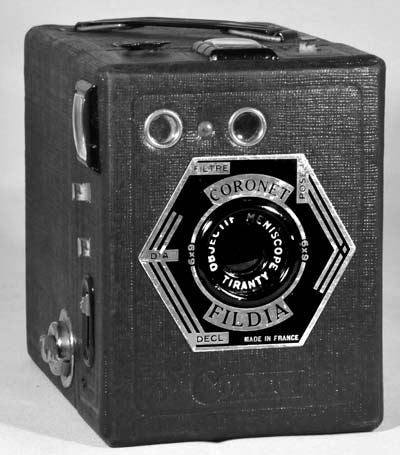Coronet Fildia
Specification

| Manufacturer | : | Coronet |
|---|---|---|
| Produced | : | 1947 |
| Classification | : | Medium Format |
| Body Type | : | Box |
| Construction | : | Cardboard/Metal/Wood/ |
| Film Type | : | 120 |
| Film Width | : | 62mm |
| Image Size | : | 2¼ x 3¼ in |
| No. of Images | : | 8 |
| Lens Type | : | Tiranty Meniscus |
| Focus Type | : | Fixed |
| Focal Length | : | 105mm |
| Focus Range | : | 8ft to inf. |
| Aperture Type | : | Multihole |
| Aperture | : | f/11, f/16 |
| Shutter Type | : | Rotary |
| Shutter Speeds | : | I*(1/50 sec) |
| Size (w x h x d) | : | 85 x 105 x 120 mm |
| Weight | : | 416g |
| * Measured on this camera | ||
Art Deco Credentials
![]()
![]()
Acceptable: Modest and restricted
- Produced during the main Art Deco period;
- Geometric black and chrome pattern on front plate;
- Chromed S-shaped winder;
- Leatherette embossed with double lined rectangles on sides and back;
- Leatherette embossed with triangles on top;
- Leather strap.
Description
The Coronet Fildia camera was manufactured by the Tiranty company based in Paris, France. The Coronet Camera Company of England worked in association with Tiranty starting after the war around 1947. This was in order to comply with new restrictions established by the French government.
The Fildia body is made of cardboard with a leatherette fabric cover. The leatherette cover has a tiny grid design, embossed with double lined rectangles on sides and back, with triangles embossed on the top. The hexagonal front plate has an Art Deco design and shows the name and place of manufacture, as well as indications for each of the cameras functions :- Decl = shutter release, Dia = aperture control, Filtre= filter control and Pose = time control.
It is capable of capturing 12 2¼ x 3¼ in (6 x 9 cm) exposures on 120 roll film. The camera is equipped with a fixed Tiranty meniscus lens with two apertures (f/11, f/16). It is capable of both instant and timed modes. A yellow filter can be moved into place.
It has two viewfinders, one for landscape and one for portrait mode. The top-mounted handle is made from metal and is placed diagonally on the top. The red window on the back has a swinging cover. There is no tripod socket.
There are many colour variants such as marble, blue waves, turquoise. These are much less common than this standard black version. Also in black there are two models, one having the lettering in red and blue.
How to Use
This camera takes 120 film which is easily available.
As the shutter speed is only 1/50s, it is advisable to use a tripod with a flat top to get clear shake free images. However, holding it against a wall or other solid object would work as well. For quick snapshots, hold it firmly against your body.
If you don't want to bother with an exposure meter, follow the guide shown. It is based on the 'Sunny 16' rule. Film is so forgiving and will produce acceptable results even when overexposed by 2 or 3 stops or underexposed by 1 stop.
The tables assume that the sun is at least 30 degrees above the horizon - that's 10am - 5pm on a summers day (May - August) in the UK.
Remember that the exposure guide in the manual may not be helpful as it is based on the use of old film with a low ISO value.
Using ISO 100/125 film - shutter speed 1/50s
| Weather Conditions | Shadow Detail | Aperture | Exposure |
|---|---|---|---|
 Sunny SunnySnow/Sand | Dark with sharp edges | f/16 | +2 Stops Overexposed Acceptable |
 Sunny Sunny | Distinct | f/16 | +1 Stop Overexposed Acceptable |
 Slight Overcast Slight Overcast | Soft around edges | f/16 | Good |
 Overcast Overcast | Barely visible | f/11 | Good |
 Heavy Overcast Heavy Overcast | None | f/11 | -1 Stop Underexposed Acceptable |
 Open Shade Open Shade/Sunset | None | f/11 | -2 Stops Underexposed Not Acceptable |